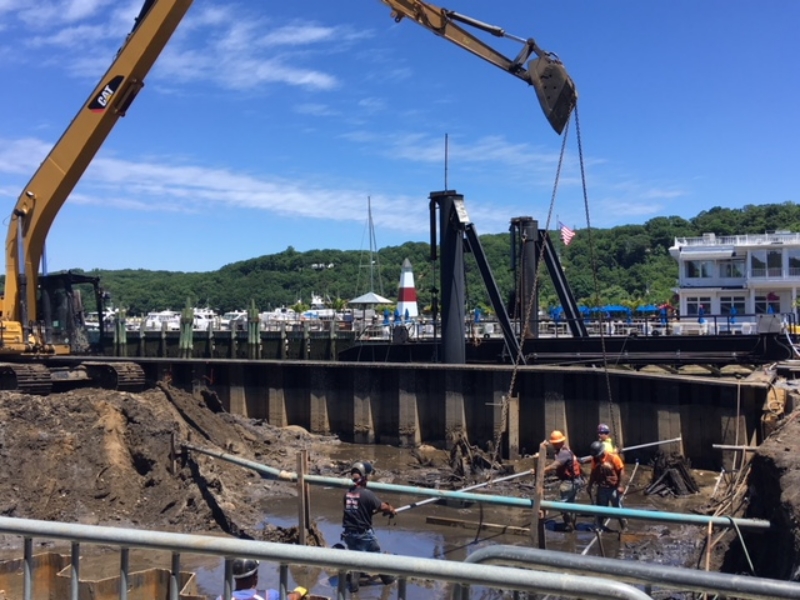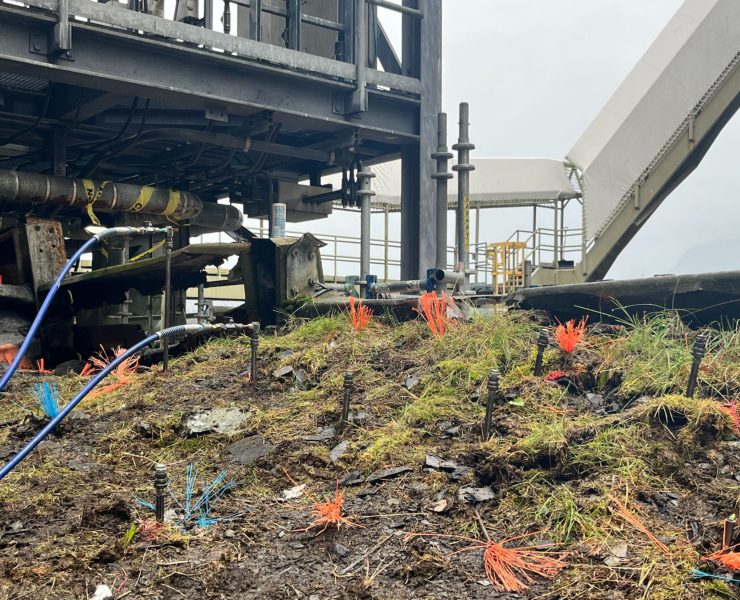Nucor Skyline Provides Steel Sheet Pile to Replace Deteriorating Sheet Pile at Port Jefferson

HISTORY
From the first ferry service in 1872, Port Jefferson has served as a maritime hub in the Long Island area. The Bridgeport and Port Jefferson Steamboat Company was founded in
1883, and is one of the oldest ferry companies in America, running between Port Jefferson, NY and Bridgeport, CT. Three ferries run every hour on weekends and throughout the summer and the remainder of the year ferries run every 90 minutes, transporting over 1.3 million passengers and 500,000 cars in 2017.
The pier at the Port Jefferson Ferry Terminal has been standing for about a century. Made of wood timbers initially, it has been reframed over the years, and as recently as the late
1980s with sheet piles.
PROBLEM
The sheet pile installed in the 1980s had deteriorated in many places and needed to be replaced. Much of the original steel exhibited a 30% to 70% section loss with holes that caused fill to be lost, resulting in sink holes on the deck. The majority of the corrosion was believed to be caused by the thrusters of the ferry. However, in areas not affected by the thrusters, the cause may have been microbe-induced corrosion due to pitting, crevice corrosion, or stray current.
As with many marine construction projects, weather, tides, tight schedules, and restrictions on noise and construction made the Port Jefferson Ferry Terminal a challenging project. Chesterfield Associates had to work through severe winter storms, plus schedule construction to keep the ferries up and running without hampering travel schedules for the thousands of passengers served. Ferries shifted between the two slips in order to keep the construction moving along.
The seven-foot tide change gave workers a small window to install the tie rods. The threaded bar and walers were used in combination to tie the bulkhead wall to the deadman wall. Installation could only be accomplished at the mid-point in the tidal range during daylight hours. Old wooden pilings and other debris often found their way into the path of the new
steel sheet piles as they were driven, causing obstructions that needed to be cleared. Divers were employed to enter the water whenever driving stopped, in order to determine the
cause of the obstruction.
SOLUTION
Initially, the bulk of the project was designed with AZ 38-700 and PZ 35 for a small part of the wall. However, working with Chesterfield Associates, Nucor Skyline, and the ferry company, the engineering firm, GPI, noted that the north end of the wall was required to take an axial load for a fixed pier extension, and the sheet pile was changed to AZ 40-700N
and AZ 46-700N for durability. Deflection was a consideration, as well, because the dock was subject to vehicular loading. The design aimed to keep deflection between 1 to 2 inches.
In addition, the sheeting running east/west at the north end of the pier had an exposed height of up to 38 feet, hence AZ 40-700N was recommended to meet design parameters.

“Working with the Skyline staff has been advantageous throughout all phases of this project. The Skyline staff optimized this project by bringing to the table different sheet piling solutions, while keeping material availability in mind. Skyline’s alternative solutions provided the required structural capacity with lighter weight sections than the sheet piling sections typically used.” – Linda DeSimone, PE, GPI
Chesterfield Associates worked with their project partner, Nucor Skyline, who manufactured and delivered AZ 26-700, AZ 40- 700N, and AZ 46-700N sheet piles in lengths from 50 to 90 feet for this project. The longest sheet piles weighed approximately 8 tons a pair, and had to be transported on specialized stretch trailers in two doubles to the jobsite. The new, thicker 5/8” piles were upgraded from the initial specification of Grade 50 to Grade 60 to meet the durability requirements of a longer service life of 50 to 60 years. In addition, aluminum anodes were installed to help protect the steel sheet piles. While the anodes will need to be replaced every ten years, they will contribute to the service life of the sheet piles.
“This project required timely manufacturing, coating and transport of steel sheet piling and tie rod components. Transportation required specialized trucking and close coordination with Nucor Skyline. Storage space at the site was very limited so deliveries needed to be precisely planned. The staff in Skyline’s Middletown NJ office did a great job of setting up the trucking to get us the right material when we needed it.” – Jeff Grube, Chesterfield Associates, Inc.
The AZ 26-700 pile was used instead of the originally requested PZ 35, as it is the same strength, but approximately 15% lighter and stiffer and worked better for the needs of the project, reducing the overall project cost by about 10%. In order to extract the old sheet piling from around the pier, Chesterfield Associates used an ICE Model 416 hydraulic vibratory driver/extractor that was mounted on a crawler crane. In several places, the old sheet piling was left in place due to the extent of corrosion and the difficulty to remove them. All of the
new piling was driven in place using a more powerful ICE Model 50B vibratory hammer which had the size and energy to drive up to 90 feet in the soil conditions at the pier.
PROJECT PARTNERS
Owner
Bridgeport and Port Jefferson Steamboat
Company – Port Jefferson, NY
Design Engineer of Record
GPI – Babylon, NY
Excavation/Drilling:
Chesterfield Associates – Westhampton Beach, NY
Products
Sheet Pile: AZ 26-700, AZ 40-700, and AZ 46-700 Grade 60
Threaded Bar: GR 150 galvanized threaded bar (1 3⁄4”, 2 1⁄4”, and 2 1⁄2”)
Accessories: GR 150 galvanized oversized hex nut and oversized coupler
PROJECT TIME FRAME
October 2017 to July 2018

















